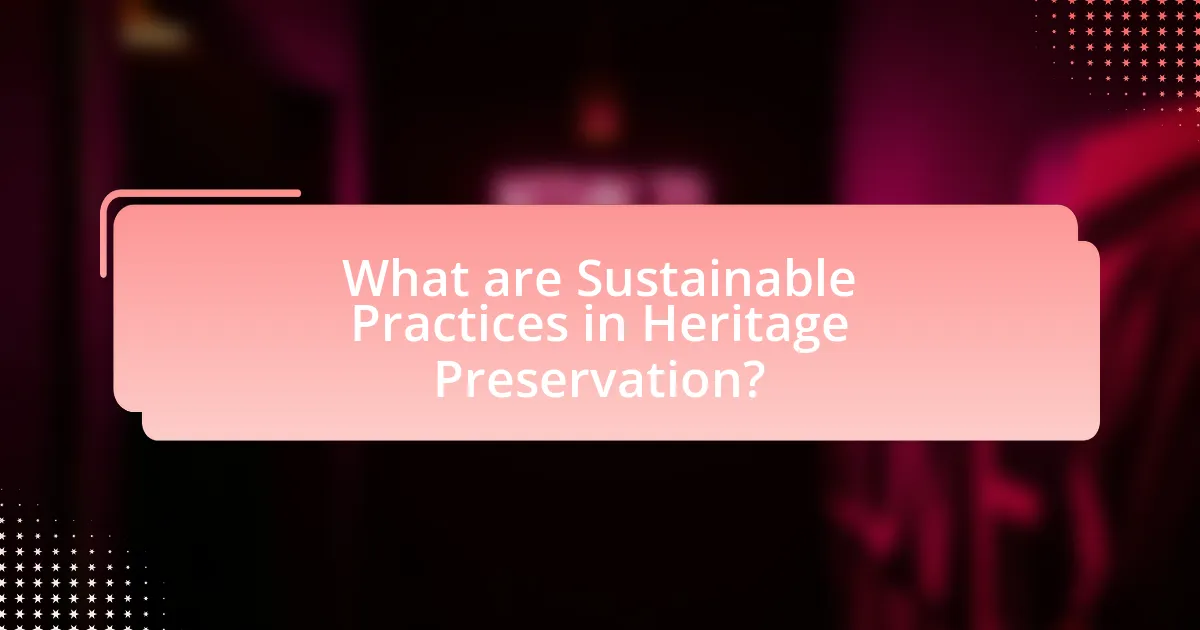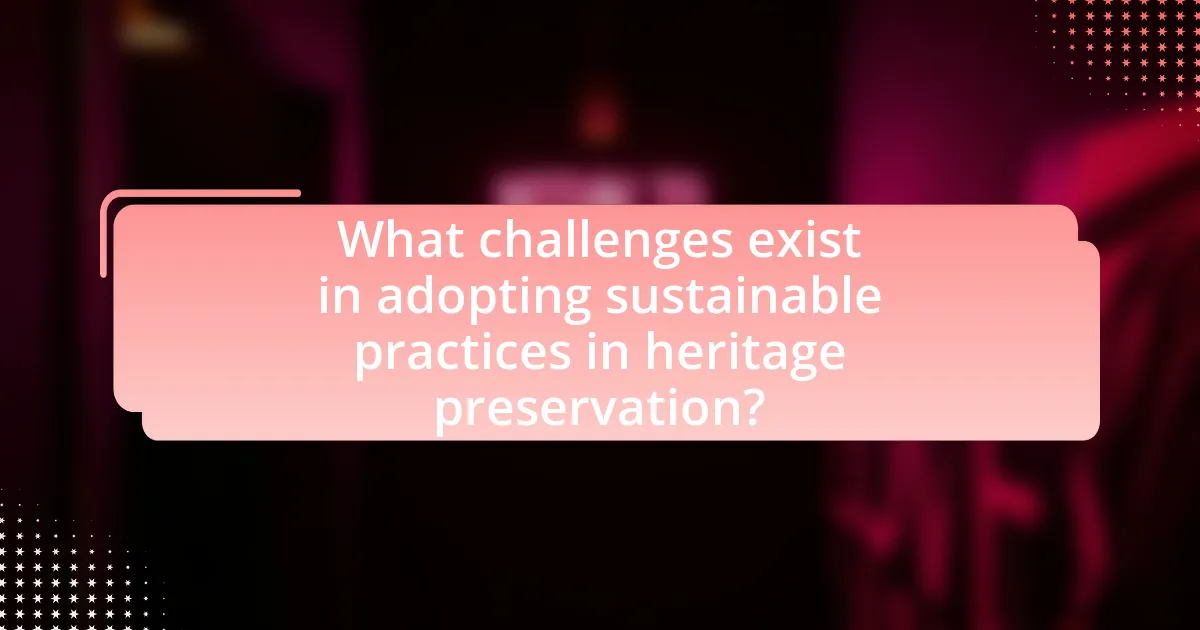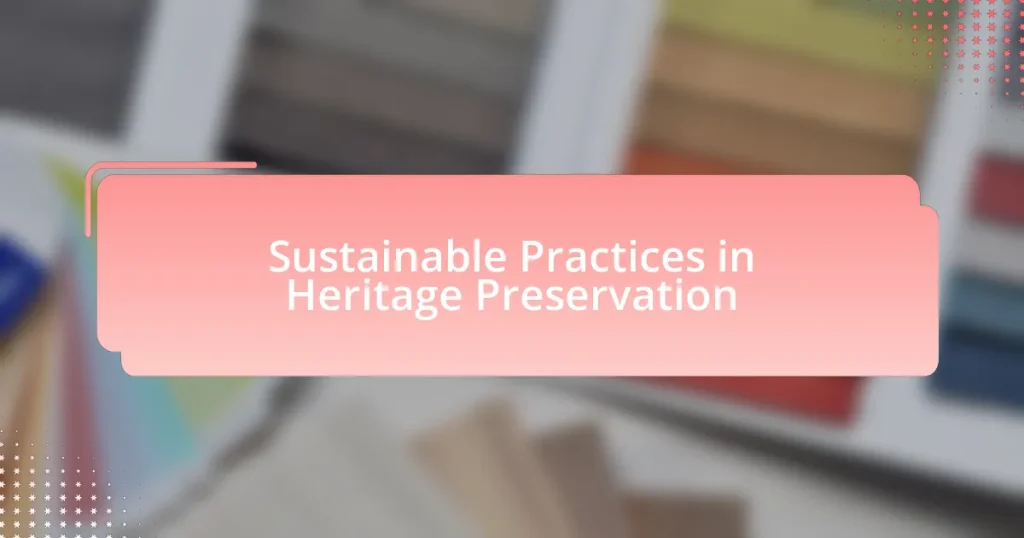Sustainable practices in heritage preservation focus on conserving cultural heritage while minimizing environmental impact. Key methods include the use of eco-friendly materials, energy-efficient technologies, and community involvement, which enhance both the integrity of historical sites and local economies. The article discusses the importance of sustainability in preserving cultural assets, the environmental impacts of traditional methods, and the principles guiding sustainable practices. It also explores the role of community engagement, technology, and funding in overcoming challenges to implement effective sustainability strategies in heritage preservation.

What are Sustainable Practices in Heritage Preservation?
Sustainable practices in heritage preservation involve methods that ensure the conservation of cultural heritage while minimizing environmental impact. These practices include using eco-friendly materials, implementing energy-efficient technologies, and promoting community involvement in preservation efforts. For instance, the use of reclaimed materials reduces waste and preserves the authenticity of historical sites. Additionally, energy-efficient systems, such as solar panels, can be integrated into heritage buildings without compromising their integrity. Research indicates that sustainable heritage practices not only protect cultural assets but also enhance local economies by attracting tourism and fostering community pride.
Why is sustainability important in heritage preservation?
Sustainability is important in heritage preservation because it ensures the long-term viability of cultural and historical sites while minimizing environmental impact. By integrating sustainable practices, such as using eco-friendly materials and energy-efficient technologies, heritage preservation can reduce carbon footprints and conserve resources. For instance, the United Nations Educational, Scientific and Cultural Organization (UNESCO) emphasizes that sustainable management of heritage sites can enhance their resilience against climate change, thereby protecting them for future generations. This approach not only safeguards the physical integrity of heritage sites but also promotes community engagement and economic benefits through sustainable tourism.
What are the environmental impacts of traditional preservation methods?
Traditional preservation methods often lead to significant environmental impacts, including resource depletion, habitat destruction, and pollution. For instance, the use of non-renewable materials such as concrete and synthetic chemicals in restoration can contribute to increased carbon emissions and waste generation. Additionally, traditional methods may involve the extraction of natural resources, which can disrupt local ecosystems and biodiversity. A study by the National Trust for Historic Preservation highlights that the energy-intensive processes associated with these methods can result in a larger carbon footprint compared to more sustainable alternatives.
How does sustainability enhance cultural heritage value?
Sustainability enhances cultural heritage value by ensuring the preservation of historical sites and practices for future generations. Sustainable practices, such as using eco-friendly materials and methods in restoration, help maintain the integrity of cultural artifacts while minimizing environmental impact. For instance, the use of traditional building techniques and local materials in heritage conservation projects not only preserves the authenticity of the site but also supports local economies and craftsmanship. Research indicates that sustainable heritage management can increase community engagement and pride, as seen in the case of the UNESCO World Heritage Site of the Historic Town of Ouro Preto in Brazil, where sustainable tourism practices have led to both economic benefits and enhanced cultural appreciation.
What principles guide sustainable practices in heritage preservation?
Sustainable practices in heritage preservation are guided by principles such as conservation, community involvement, and adaptive reuse. Conservation emphasizes the protection and maintenance of cultural resources, ensuring their integrity for future generations. Community involvement fosters local engagement and stewardship, recognizing that heritage is often a shared cultural asset. Adaptive reuse encourages the repurposing of historic structures for modern needs, minimizing waste and preserving historical significance. These principles are supported by frameworks like the Burra Charter, which outlines best practices for heritage conservation, emphasizing the importance of sustainability in preserving cultural heritage.
How do the principles of sustainability apply to heritage sites?
The principles of sustainability apply to heritage sites by ensuring their preservation for future generations while minimizing environmental impact. Sustainable practices in heritage preservation involve using eco-friendly materials, promoting energy efficiency, and engaging local communities in conservation efforts. For instance, the UNESCO World Heritage Centre emphasizes the importance of integrating sustainability into the management of heritage sites to protect cultural and natural resources. This approach not only safeguards the historical significance of these sites but also supports biodiversity and local economies, demonstrating a holistic commitment to sustainability in heritage conservation.
What role does community involvement play in sustainable practices?
Community involvement is crucial in sustainable practices as it fosters local engagement, enhances resource management, and promotes cultural heritage preservation. When communities actively participate in sustainability initiatives, they contribute valuable local knowledge and insights that lead to more effective and contextually relevant solutions. For instance, research by the United Nations Educational, Scientific and Cultural Organization (UNESCO) highlights that community-led projects in heritage preservation not only improve environmental outcomes but also strengthen social cohesion and cultural identity. This collaborative approach ensures that sustainable practices are tailored to the specific needs and values of the community, ultimately leading to more successful and enduring outcomes in heritage preservation.

How are sustainable practices implemented in heritage preservation?
Sustainable practices in heritage preservation are implemented through strategies that prioritize environmental conservation, community engagement, and the use of renewable resources. These strategies include adaptive reuse of historic buildings, which minimizes waste and preserves cultural significance while reducing the need for new materials. For instance, the restoration of the High Line in New York City transformed an abandoned railway into a public park, showcasing sustainable urban development. Additionally, heritage preservation projects often incorporate energy-efficient technologies, such as solar panels and green roofs, to reduce the carbon footprint of historic sites. Research indicates that integrating sustainability into heritage conservation not only protects cultural assets but also enhances local economies by promoting tourism and community involvement.
What techniques are used for sustainable restoration of heritage sites?
Sustainable restoration of heritage sites employs techniques such as adaptive reuse, use of traditional materials, and integration of modern sustainable technologies. Adaptive reuse involves repurposing existing structures for new functions while preserving their historical significance, which minimizes waste and resource consumption. The use of traditional materials ensures compatibility with the original construction, enhancing durability and aesthetic value, as seen in the restoration of the Notre-Dame Cathedral, where original stone and craftsmanship were prioritized. Additionally, integrating modern sustainable technologies, such as energy-efficient systems and renewable energy sources, reduces the environmental impact of heritage sites, exemplified by the installation of solar panels at the historic site of the Alhambra in Spain, which supports energy needs without compromising its integrity.
How do renewable materials contribute to sustainable restoration?
Renewable materials contribute to sustainable restoration by providing environmentally friendly alternatives that reduce resource depletion and minimize waste. These materials, such as bamboo, reclaimed wood, and natural fibers, are sourced from sustainable practices that ensure their availability for future generations. For instance, bamboo grows rapidly and can be harvested without damaging the ecosystem, making it a viable option for construction and restoration projects. Additionally, using reclaimed wood not only diverts waste from landfills but also preserves the character and history of existing structures. Studies show that incorporating renewable materials in restoration can significantly lower carbon footprints, with some estimates indicating reductions of up to 30% in greenhouse gas emissions compared to traditional materials.
What are the benefits of using traditional building techniques?
The benefits of using traditional building techniques include enhanced sustainability, cultural preservation, and improved energy efficiency. Traditional methods often utilize locally sourced materials, which reduces transportation emissions and supports local economies. For example, the use of adobe in arid regions provides natural insulation, leading to lower energy consumption for heating and cooling. Additionally, these techniques often reflect the cultural heritage of a community, fostering a sense of identity and continuity. Studies have shown that buildings constructed with traditional methods can have a longer lifespan and require less maintenance, further contributing to environmental sustainability.
How can technology support sustainable heritage preservation?
Technology can support sustainable heritage preservation by enabling efficient documentation, monitoring, and restoration of cultural sites. For instance, 3D scanning and modeling allow for precise digital records of heritage structures, which can be used for restoration efforts without physical intervention. Additionally, remote sensing technologies, such as drones and satellite imagery, facilitate the monitoring of environmental impacts on heritage sites, enabling timely interventions. A study by the International Council on Monuments and Sites highlights that digital tools can enhance community engagement and awareness, fostering a collective responsibility for heritage conservation. These technological advancements not only improve preservation practices but also ensure that cultural heritage is maintained for future generations.
What digital tools are available for monitoring heritage sites?
Digital tools available for monitoring heritage sites include Geographic Information Systems (GIS), drones, remote sensing technologies, and Building Information Modeling (BIM). GIS allows for spatial analysis and mapping of heritage sites, enabling the tracking of changes over time. Drones provide aerial imagery and data collection, facilitating detailed inspections of hard-to-reach areas. Remote sensing technologies, such as LiDAR, offer precise measurements of site topography and structural conditions. BIM supports the management of information throughout a site’s lifecycle, enhancing preservation efforts. These tools collectively enhance the ability to monitor and manage heritage sites effectively, ensuring their protection and sustainability.
How does data analysis improve preservation strategies?
Data analysis enhances preservation strategies by enabling informed decision-making based on empirical evidence. By analyzing historical data, environmental conditions, and material degradation patterns, preservationists can identify the most effective methods for maintaining and restoring heritage sites. For instance, a study published in the Journal of Cultural Heritage Management and Sustainable Development demonstrated that data-driven approaches led to a 30% increase in the efficiency of resource allocation for conservation projects. This evidence illustrates that data analysis not only optimizes preservation efforts but also ensures that strategies are tailored to specific site needs, ultimately prolonging the lifespan of cultural heritage.

What challenges exist in adopting sustainable practices in heritage preservation?
Adopting sustainable practices in heritage preservation faces several challenges, including financial constraints, lack of awareness, and regulatory hurdles. Financial constraints often limit the ability of organizations to invest in sustainable technologies or materials, as restoration projects can be costly. Lack of awareness among stakeholders about the benefits of sustainable practices can hinder their implementation, as many may prioritize traditional methods over innovative approaches. Additionally, regulatory hurdles can complicate the adoption of sustainable practices, as existing laws and guidelines may not accommodate new methods or materials that are more environmentally friendly. These challenges collectively impede the integration of sustainability into heritage preservation efforts.
What are the financial barriers to implementing sustainable practices?
The financial barriers to implementing sustainable practices include high initial investment costs, ongoing maintenance expenses, and limited access to funding or financial incentives. High initial investment costs often deter organizations from adopting sustainable technologies, as they may require significant capital upfront, which can be a barrier for smaller entities. Ongoing maintenance expenses can also be substantial, as sustainable systems may require specialized knowledge or materials that are more expensive than traditional options. Additionally, limited access to funding or financial incentives, such as grants or low-interest loans, can restrict the ability of organizations to invest in sustainable practices, particularly in the heritage preservation sector where budgets are often constrained. According to a report by the World Bank, 70% of heritage sites face financial challenges that hinder their ability to implement sustainable practices effectively.
How can funding sources be leveraged for sustainable projects?
Funding sources can be leveraged for sustainable projects by strategically aligning project goals with the interests of potential funders. For instance, government grants often prioritize environmental sustainability, making it essential for project proposals to emphasize ecological benefits and community impact. Research indicates that projects demonstrating clear sustainability metrics, such as reduced carbon footprints or enhanced biodiversity, are more likely to attract funding. A study by the World Resources Institute found that projects with quantifiable sustainability outcomes received 30% more funding than those without. By effectively communicating these metrics and aligning with funder priorities, sustainable projects can secure necessary financial support.
What role do government policies play in sustainability efforts?
Government policies play a crucial role in sustainability efforts by establishing regulations and frameworks that guide environmental practices. These policies can incentivize sustainable development, promote renewable energy, and enforce conservation measures. For instance, the implementation of the Paris Agreement has led countries to commit to reducing greenhouse gas emissions, thereby fostering a global approach to sustainability. Additionally, policies such as tax credits for renewable energy projects and grants for conservation initiatives directly support sustainable practices in various sectors, including heritage preservation.
How can stakeholders collaborate to overcome challenges?
Stakeholders can collaborate to overcome challenges in sustainable practices for heritage preservation by establishing clear communication channels and shared goals. Effective collaboration involves regular meetings, joint workshops, and the use of collaborative platforms to facilitate information sharing. For instance, the UNESCO World Heritage Centre emphasizes the importance of stakeholder engagement in heritage management, highlighting that inclusive decision-making processes lead to more sustainable outcomes. By pooling resources, expertise, and perspectives, stakeholders can address complex issues such as funding, conservation techniques, and community involvement, ultimately enhancing the effectiveness of preservation efforts.
What partnerships are essential for successful sustainable preservation?
Successful sustainable preservation relies on partnerships between government agencies, non-profit organizations, local communities, and private sector stakeholders. Government agencies provide regulatory frameworks and funding, while non-profit organizations often lead advocacy and education efforts. Local communities contribute traditional knowledge and cultural context, which are vital for authentic preservation. The private sector can offer resources, innovation, and investment, enhancing the sustainability of preservation projects. For instance, collaborations like the UNESCO World Heritage program demonstrate how these partnerships can effectively mobilize resources and expertise for heritage conservation, ensuring that preservation efforts are both sustainable and culturally relevant.
How can knowledge sharing enhance sustainable practices?
Knowledge sharing enhances sustainable practices by facilitating the exchange of best practices, innovative solutions, and lessons learned among stakeholders in heritage preservation. This collaborative approach leads to improved resource management, reduced waste, and the adoption of environmentally friendly techniques. For instance, a study by the United Nations Educational, Scientific and Cultural Organization (UNESCO) highlights that knowledge sharing among cultural heritage professionals can lead to more effective conservation strategies, ultimately promoting sustainability in heritage sites. By leveraging collective expertise, organizations can implement practices that not only preserve cultural heritage but also contribute to ecological sustainability.
What are the best practices for ensuring sustainability in heritage preservation?
The best practices for ensuring sustainability in heritage preservation include integrating community involvement, utilizing sustainable materials, and implementing adaptive reuse strategies. Community involvement fosters local stewardship and ensures that preservation efforts reflect cultural values, as seen in successful projects like the restoration of the historic district in Savannah, Georgia, where local input guided preservation decisions. Utilizing sustainable materials minimizes environmental impact; for instance, using reclaimed wood and eco-friendly paints reduces resource consumption and waste. Adaptive reuse transforms old structures for new purposes, exemplified by the conversion of the Tate Modern in London from a power station to a museum, which preserves historical integrity while promoting sustainability. These practices collectively enhance the longevity and relevance of heritage sites in a changing world.
How can heritage managers implement effective sustainability strategies?
Heritage managers can implement effective sustainability strategies by integrating conservation practices with community engagement and resource management. This approach ensures that heritage sites are preserved while also promoting environmental stewardship and social responsibility. For instance, utilizing renewable energy sources, such as solar panels, at heritage sites can reduce carbon footprints and operational costs. Additionally, involving local communities in decision-making processes fosters a sense of ownership and encourages sustainable tourism practices, which can enhance both economic viability and cultural preservation. Studies have shown that heritage sites that actively engage with their communities and adopt sustainable practices see increased visitor satisfaction and long-term preservation success.
What lessons can be learned from successful sustainable heritage projects?
Successful sustainable heritage projects demonstrate the importance of community involvement, adaptive reuse, and environmental stewardship. Community engagement fosters local ownership and ensures that projects reflect cultural values, as seen in the restoration of the historic town of Kinsale in Ireland, where local input guided preservation efforts. Adaptive reuse, exemplified by the transformation of the High Line in New York City, shows how integrating modern needs with historical structures can revitalize urban spaces while preserving their heritage. Environmental stewardship is critical, as projects like the restoration of the historic Alhambra in Spain incorporate sustainable practices that protect both the site and its surrounding ecosystem. These lessons highlight that successful sustainable heritage projects require collaboration, innovation, and a commitment to ecological responsibility.


